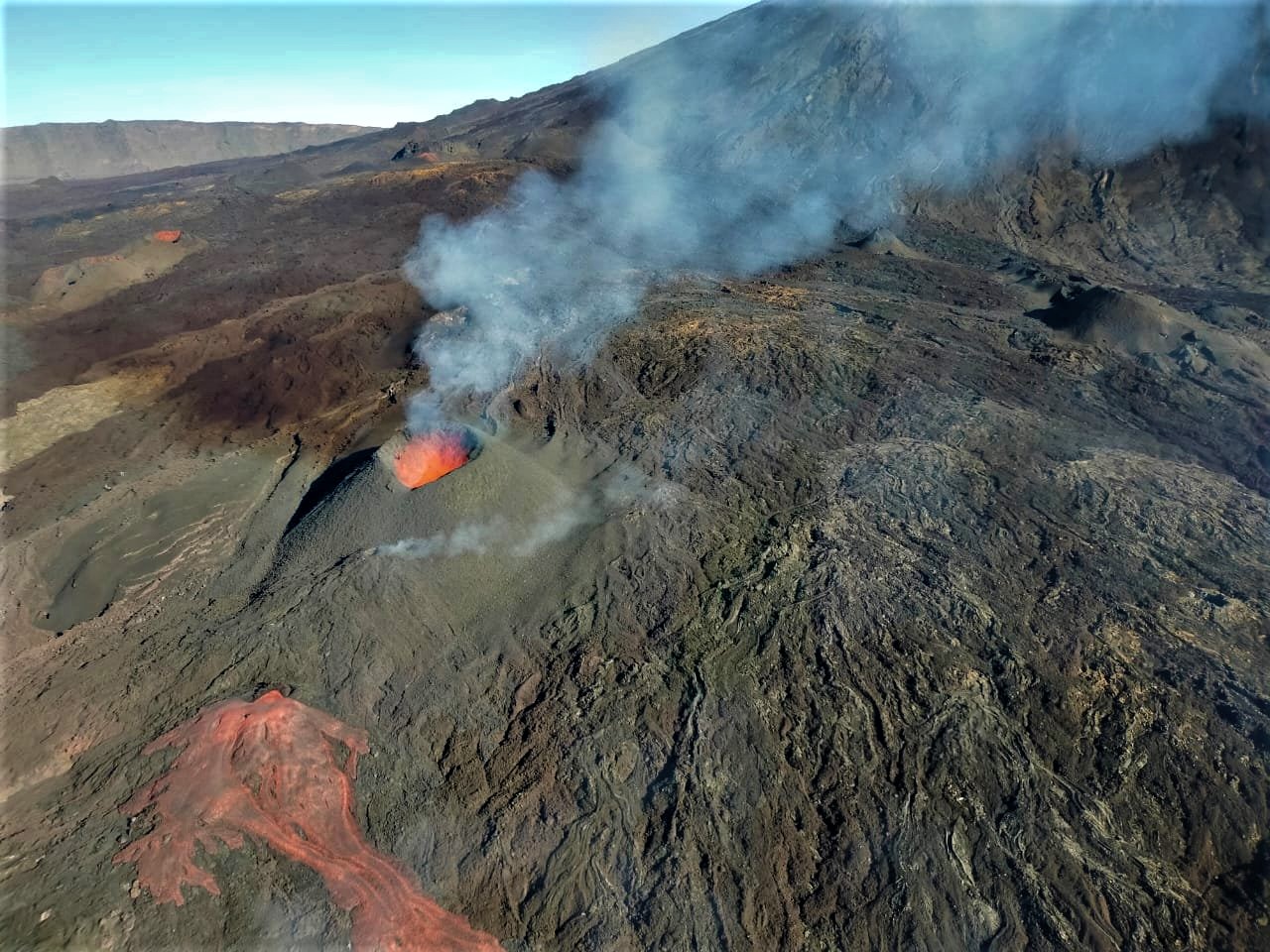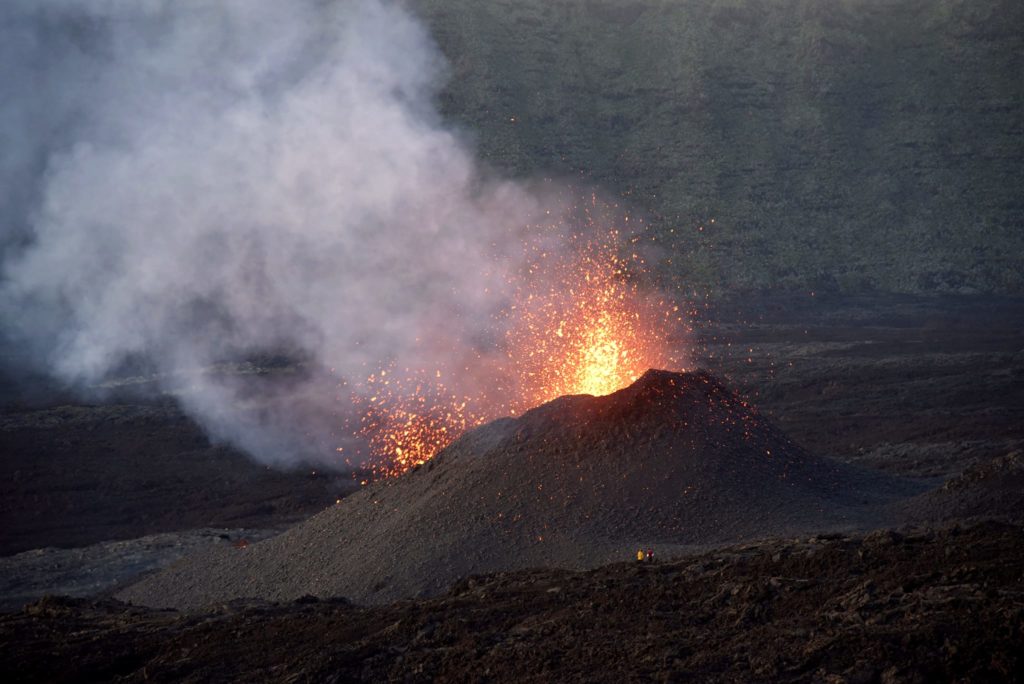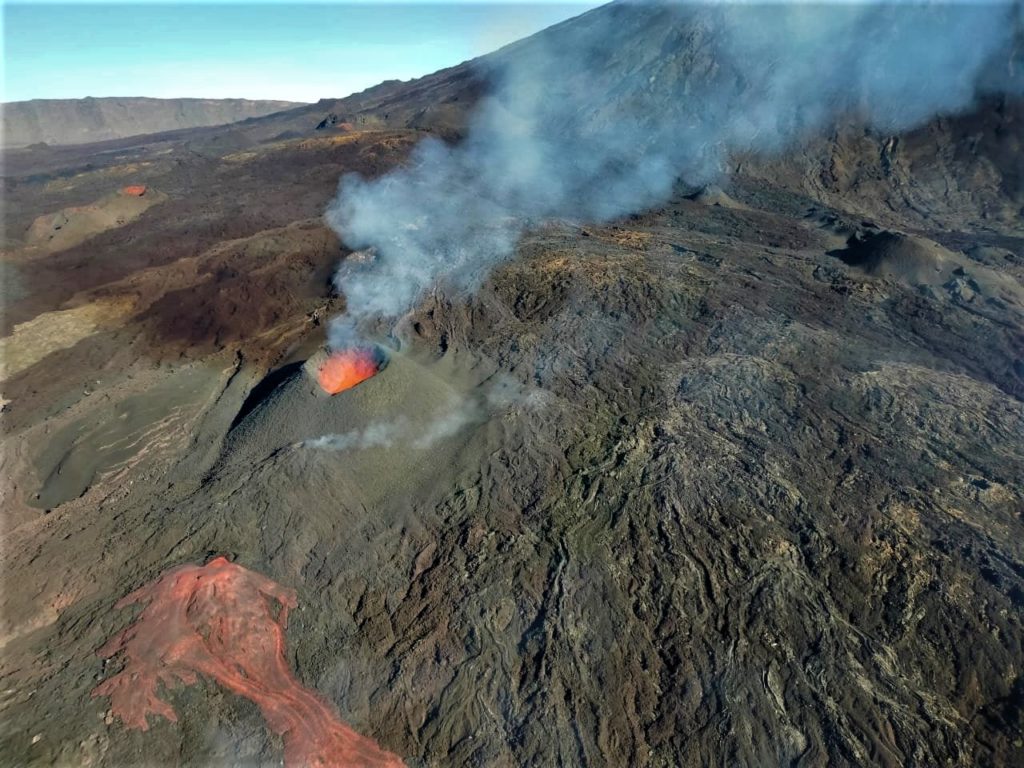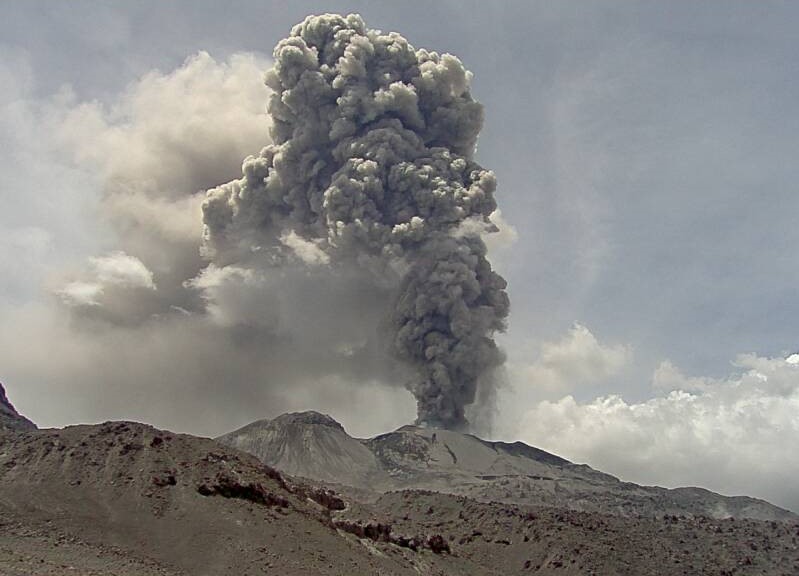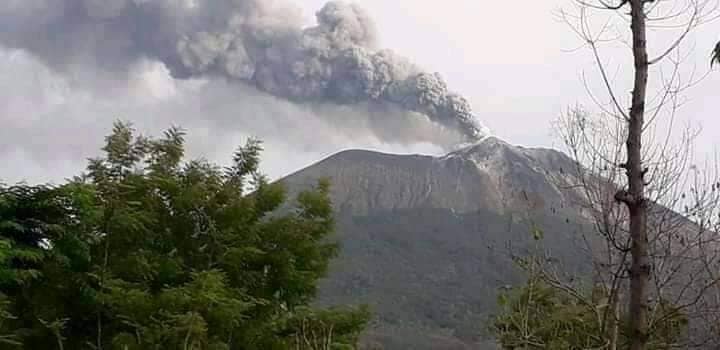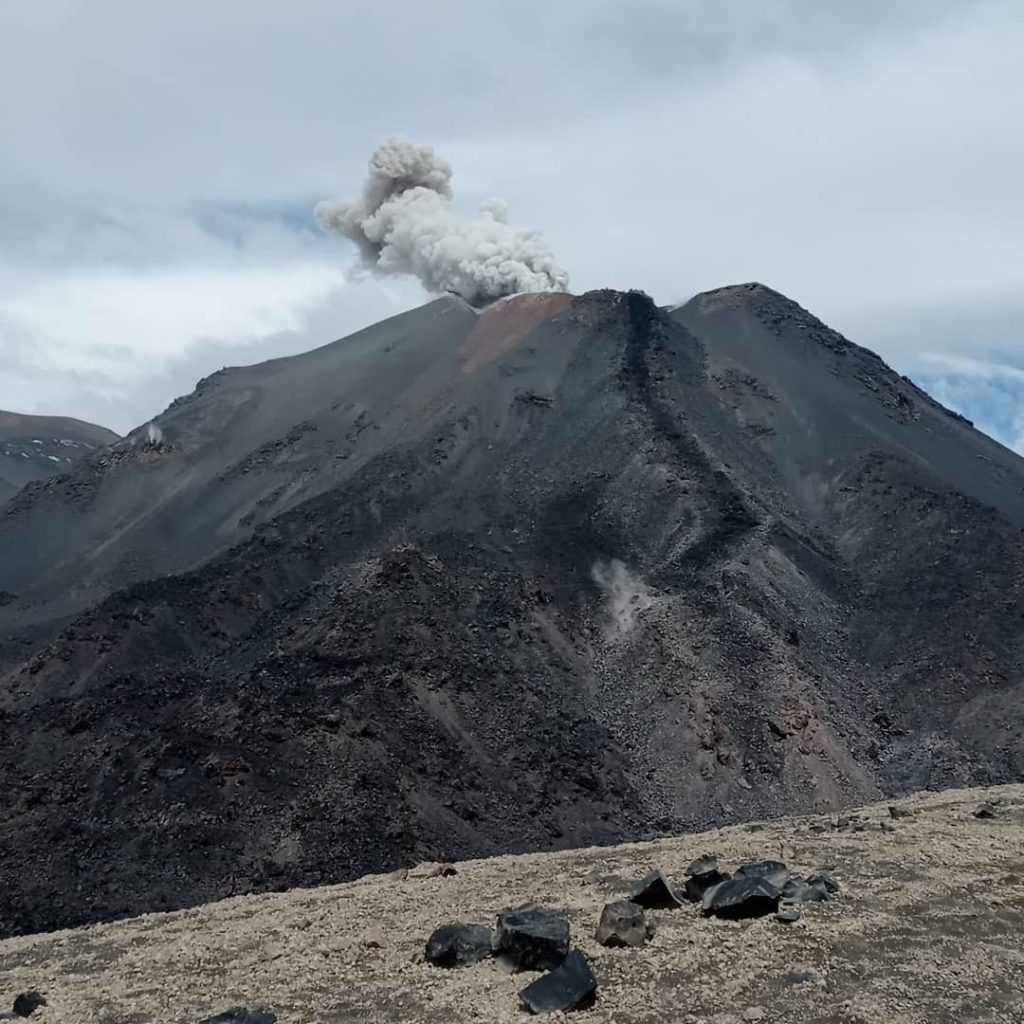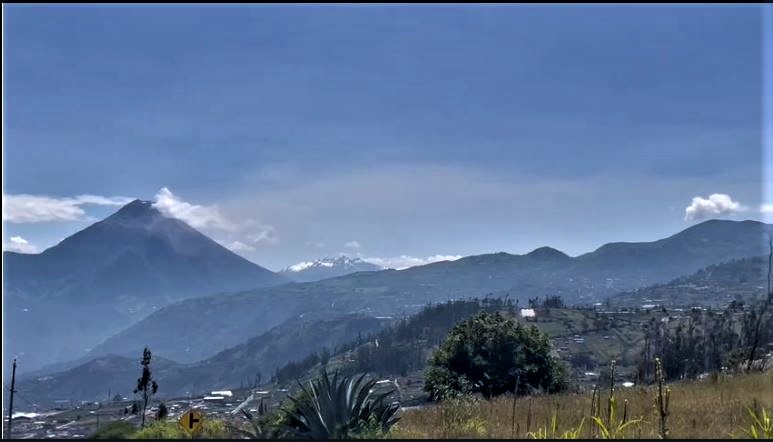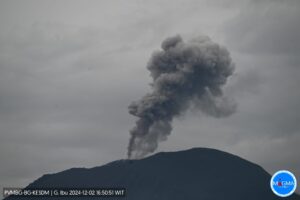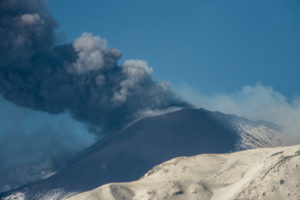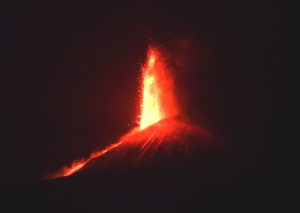January 04 , 2022.
La Réunion Island , Piton de la Fournaise :
Press release of January 03, 2022 – 4:00 p.m.
The eruption that began on December 22, 2021 at around 3:30 a.m. local time continues. Over the last 24 hours the amplitude of the eruptive tremor (indicator of an emission of lava on the surface) still shows fluctuations. The fluctuations observed can be linked either to:
– the cone and the field of lava tunnels downstream of the cone, which undergo phases of construction and dismantling, thus influencing the speed of lava flows at the level of the vent;
– or to punctual releases of pockets of gas trapped in the supply ducts which can be released suddenly leading to an increase in the tremor.
The average amplitude of the tremor is (over the last few hours) about 50% of its initial amplitude.
The latest observations still show lava fountain activity within the cone that has built up since the start of the eruption. The videos from the webcams of the OVPF-IPGP-IRT last night, as well as the observations made today from the Piton de Bert, show activity with lava fountains which occasionally exceed the height of the cone. Numerous resurgences of lava flows are still visible at the roof of the lava tunnel that has developed downstream from the cone. These resurgences are sporadic and can last from a few minutes to
a few hours .
Over the last 24 hours:
– No volcano-tectonic earthquakes have been recorded.
– Surface deformations no longer show significant signals.
– The CO2 concentrations in the soil in the Gîte du volcan sector have been increasing for several days. This parameter will be monitored over the next few days because it may be linked to the arrival of new magma, coming from deeper areas, at the level of the shallow reservoir.
– Lava flows could be estimated by satellite method with the HOTVOLC platform (OPGC – Clermont Auvergne University). They were between 2 and 10 m3 / sec. These variations are explained by the method, which relies on the infrared radiation of the flow, the perception of which by satellites can be largely influenced by the weather conditions above the flows as well as the surface conditions of the flows.
No assessment of the position of the flow front could be made. But given the relief with gently sloping slopes in the area, the lava field continues to extend mainly laterally and by thickening at the level of the network of lava tunnels set up on the plateau downstream of the eruptive cone.
Alert level: Alert 2-1 (eruption in the Enclos ).
Source : OVPF/ IPGP.
Photo : Frederick Leveneur via Facebook , PGHM via OVPF.
Peru , Sabancaya :
Analysis period: from December 27, 2021 to January 02, 2021, Arequipa, January 03, 2021.
Alert level: ORANGE
The Geophysical Institute of Peru (IGP) reports that the eruptive activity of the Sabancaya volcano remains at moderate levels, that is to say with the recording of an average of 32 daily explosions, with columns of ash and gas up to 2.8 km altitude above the summit of the volcano and their consequent dispersion. Therefore, for the following days, no significant change is expected in eruptive activity.
The IGP recorded and analyzed the occurrence of 746 earthquakes of volcanic origin, associated with the circulation of magmatic fluids within the Sabancaya volcano. An average of 32 explosions was recorded daily. During this period, Volcano-Tectonic (VT) earthquakes associated with rock fractures were located mainly in the North-West of Sabancaya and presented magnitudes of M 2.9.
The monitoring of the deformation of the volcanic structure using GNSS techniques (processed with fast orbits) does not present any significant anomalies. However, in general, an inflation process was observed in the northern sector (around the Hualca Hualca volcano). Visual surveillance identified columns of gas and ash up to 2.8 km altitude above the summit of the volcano, which were scattered towards the western, southwest and northwest sectors of the Sabancaya. Satellite recordings identified the presence of 8 thermal anomalies (maximum value of 28 MW) associated with the presence of a lava body on the surface of the volcano’s crater.
RECOMMENDATIONS
• Keep the volcanic alert level in orange.
• Do not approach within a radius of less than 12 km from the crater.
Source : IGP
Photo : Ingemmet ( archive 2017).
Indonesia , Ili Lewotolok :
VOLCANO OBSERVATORY NOTICE FOR AVIATION – VONA
Issued : January 04 , 2022 .
Volcano : Ili Lewotolok (264230)
Current Aviation Colour Code : ORANGE
Previous Aviation Colour Code : unassigned
Source : Ili Lewotolok Volcano Observatory
Notice Number : 2022LEW01
Volcano Location : S 08 deg 16 min 19 sec E 123 deg 30 min 18 sec
Area : East Nusa Tenggara, Indonesia
Summit Elevation : 4554 FT (1423 M)
Volcanic Activity Summary :
Eruption with volcanic ash cloud at 02h29 UTC (10h25 local). Eruption and ash emission is not continuing.
Volcanic Cloud Height :
Best estimate of ash-cloud top is around 6474 FT (2023 M) above sea level, may be higher than what can be observed clearly. Source of height data: ground observer.
Other Volcanic Cloud Information :
Ash-cloud moving to East southeast
Remarks :
Seismic activity is dominated by gas emission earthquake.
The volcano was clearly visible until it was covered in fog. The smoke from the crater is white / gray with low to moderate intensity, about 100-600 meters above sea level from the summit. The weather is sunny, cloudy to rainy. The wind is weak in the east.
The eruption was accompanied by a weak to moderate rumbling and an emission of incandescent material up to 200 m from the summit towards the south-east.
Seismicity is related to magmatic activity and tectonic activity. It was recorded:
– 22 eruption earthquakes / explosions
– 97 earthquakes of emissions
– 36 non-harmonic tremors
– 3 Harmonic tremors
– 1 Tornillo-type earthquake
– 3 deep volcanic earthquakes
– 2 local tectonic earthquakes
– 8 distant tectonic earthquakes
– Continuous tremor, amplitude 0.5-9.8 mm (mainly 0.5 mm)
Sources : Magma Indonésie , PVMBG.
Photos : Magma Indonésie , Kodi Setiawan(archives).
Chile , Nevados de Chillan :
Special Report on Volcanic Activity (REAV), Ñuble region, Nevados de Chillán volcanic complex, January 04, 2021, 1:05 a.m. local time (Continental Chile).
The National Service of Geology and Mines of Chile (Sernageomin) publishes the following PRELIMINARY information, obtained thanks to the monitoring equipment of the National Volcanic Monitoring Network (RNVV), processed and analyzed at the Volcanological Observatory of the Southern Andes ( Ovdas):
On Tuesday 04 January 2021, at 00:37 local time (03:37 UTC), the monitoring stations installed near the volcanic complex of Nevados de Chillán recorded an earthquake associated with the fracturing of rocks (volcano-tectonic type) in the volcanic system.
The characteristics of earthquakes after their analysis are as follows:
ORIGINAL TIME: 00:37 local time (03:37 UTC)
LATITUDE: 36.839 ° S
LONGITUDE: 71.331 ° W
DEPTH: 3.3 km
LOCAL MAGNITUDE: 3.0 Ml
OBSERVATIONS:
No surface activity associated with this event was observed, and the weather conditions in the area made it impossible to observe the summit of the volcano.
The volcanic technical alert remains at the Yellow level.
Sources et photo : Sernageomin.
Ecuador , Tungurahua :
The Geophysical Institute of the National Polytechnic School informs that through the Volcanic Observers Network (ROVE) and the IGEPN cameras, it was recorded this Monday January 3, 2022, a process of resuspension of ash on the northwest flank of the Tungurahua volcano. This process was recorded from around 12:00 TL and is due to the strong winds in the area and the dry climate. There is no change in the internal activity of the Tungurahua volcano. The Geophysical Institute of the National Polytechnic School is monitoring the activity of the volcano and will report on any changes that may be recorded.
Tungurahua, a steep-sided andesitic-dacitic stratovolcano that towers more than 3 km above its northern base, is one of Ecuador’s most active volcanoes. Three major edifices have been sequentially constructed since the mid-Pleistocene over a basement of metamorphic rocks. Tungurahua II was built within the past 14,000 years following the collapse of the initial edifice. Tungurahua II collapsed about 3,000 years ago and produced a large debris-avalanche deposit to the west. The modern glacier-capped stratovolcano (Tungurahua III) was constructed within the landslide scarp. Historical eruptions have all originated from the summit crater, accompanied by strong explosions and sometimes by pyroclastic flows and lava flows that reached populated areas at the volcano’s base. Prior to a long-term eruption beginning in 1999 that caused the temporary evacuation of the city of Baños at the foot of the volcano, the last major eruption had occurred from 1916 to 1918, although minor activity continued until 1925.
Sources : IGEPN , GVP.

